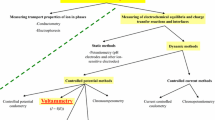Abstract
The possibility of precipitation and thin-layer Chromatographic separation of hydroxy-phenylalkylamines as tetraphenyloborates is demonstrated in several compounds of clinical and biochemical importance. The advantages of the tetraphenyloborate isolation are: 1. Stabilization of the hydroxy-phenylalkylamine bases, which are sensitive to autoxidation and alkali, because the precipitation is performed in acid range of pH; 2. simple application on thin-layer plates, because the tetraphenyloborates are soluble in acetone; 3. better Chromatographic resolution compared to those using inorganic salts of hydroxy-phenylalkylamines. Disadvantageous for quantitative isolation of some hydroxy-phenylalkylamines, especially catecholamines, is the relatively high solubility of their tetraphenyloborates in water.
Zusammenfassung
Die Möglichkeit der Fällung und dünnschicht-chromatographischen Trennung von Hydroxyphenylalkylaminen in Form ihrer Tetraphenylboranate wird am Beispiel einiger klinisch-biochemisch wichtiger Verbindungen dieser Stoffgruppe dargestellt. Die Vorteile der Tetraphenylboranat-Salzbildung sind: 1. Schutz autoxydations- und alkaliempfindlicher organischer Stickstoffbasen, da die Fällung im sauren pH-Bereich erfolgt, 2. einfache Applikationsmöglichkeit auf Dünnschicht-Platten auf Grund der Acetonlöslichkeit der Tetraphenylboranate, 3. bessere Chromatographieergebnisse im Vergleich zu denen bei Anwendung anorganischer Salze der Hydroxy-phenylalkylamine. Von Nachteil ist die relativ hohe Sättigungskonzentration einzelner wäßriger Hydroxy-phenylalkylamin-tetraphenylboranatlösungen.
Similar content being viewed by others
Literatur
Aklin, O., u. J. Dürst: Pharm. Acta Helv. 31, 457 (1956)); vgl. diese Z. 157, 235 (1957).
Beyermann, K.: diese Z. 205, 416 (1964).
—: diese Z. 212, 199 (1965); 215, 316 (1966).
Cox, H. C., E. Hardegger, F. Kögl, P. Liechti, F. Lohse u. C. A. Salemink: Helv. Chim. Acta 41, 229 (1958).
Crane, F. E., Jr.: Analyt. Chim. Acta 16, 370 (1957), Anal. Chem. 28, 1794 (1956); 30, 1426 (1958); vgl. diese Z. 157, 40 (1957); 160, 310 (1958); 167, 359 (1959).
Daly, J. W., u. B. Witkop: Angew. Chem. 75, 552 (1963).
El Gendi, S., W. Kisser u. G. Machata: Mikrochim. Acta 1965, 120.
Fischer, R., u. M. S. Karawia: Mikrochim. Acta 1953, 366; vgl. diese Z. 144, 314 (1955).
Flaschka, H., A. Holasek u. A. M. Amin: Arzneimittelforsch. 4, 38 (1954); vgl. diese Z. 144, 314 (1955).
Gawellek, F., u. P. Heitmann: Deut. Gesundh.-wesen 20, 1897 (1965).
Gayer, J.: Biochem. Z. 328, 39 (1956).
Hahn, F. L.: Ciencia (Mexiko) 14, 249 (1954).
Hannig, E., u. H. Bekemeier: Pharmazie 14, 201 (1959).
—, u. H. Haendler: Arch. Pharmaz. 290, 131 (1957).
Hauptmann, S., and J. Winter: J. Chromatog. 21, 338 (1966).
Howick, L. C., and R. T. Pflaum: Anal. Chim. Acta 19, 342 (1958); vgl. diese Z. 168, 283 (1959).
Keller, W., u. F. Weiss: Pharmazie 12, 19 (1957).
Kopin, I. J.: Z. Klin. Chem. 2, 115 (1964).
Kuhn, R., u. G. Osswald: Angew. Chem. 69, 60 (1957).
Neu, R.: diese Z. 143, 254 (1954).
Rosenthaler, E., u. F. Lüdy-Tenger: Pharm. Acta Helv. 32, 35 (1957); vgl. diese Z. 158, 139 (1957).
Schultz, O. E., u. H. Goerner: Deut. Apotheker-Ztg. 93, 585 (1953); vgl. diese Z. 141, 302 (1954).
Wachsmuth, H., u. E. Mertens: J. Pharm. Belg. 13, 58 (1958).
Wendlandt, W. W.: Chemist-Analyst 47, 6, 39 (1958); vgl. diese Z. 165, 40 (1959).
Winter, J., and S. Hauptmann: Enzym. Biol. Clin. 6, 224 (1966).
Worell, L., and W. R. Ebert: Drug Standards 24, 153 (1956).
Yanson, E., A. F. Ievins u. E. Gudriniece: Uch. Zap. Latv. Univ. 14, 9 (1957); vgl. Anal. Abstr. 6, 221 (1959).
Zeidler, L.: Z. Physiol. Chem. 291, 177 (1952).
Author information
Authors and Affiliations
Rights and permissions
About this article
Cite this article
Winter, J., Hauptmann, S. Fällung, Eigenschaften und Dünnschicht-Chromatographie der Tetraphenylboranate von Hydroxy-phenylalkylaminen. fresenius Z Anal Chem 245, 370–375 (1969). https://doi.org/10.1007/BF00423950
Received:
Issue Date:
DOI: https://doi.org/10.1007/BF00423950




